Anthony Metivier's Blog, page 10
August 16, 2022
The Memory Journal For Competition and Developing Mnemonic Systems For Learning With Johannes Mallow
 Have you ever set your mind on accomplishing something big?
Have you ever set your mind on accomplishing something big?
Johannes Mallow did.
After seeing memory techniques demonstrated on German television, he decided he would do more than merely learn them.
He committed to conquering the most challenging memory competitions on the planet.
And despite all the odds, including battling against a physical condition…
Mallow made it happen.
And today he uses his status as a world renowned memory athlete and memory expert to help others.
He’s an incredible promotor of memory sports and has helped many people experience the power of their minds.
In this exclusive interview, Mallow shares some of the lesser-known secrets of how to develop the memory systems needed to succeed.
The Role Of The Memory Journal In Memory Sports And Long Term LearningOne of the most important tools you can use when learning memory techniques is the memory journal.
Listen in as Johannes Mallow shares tips and tricks around getting one started and using it to optimize your memory skills over time.
These are tips you’ll wish you’d had years ago!
Johannes Mallow On Practical Memory TechniquesOne thing I appreciate highly in Johannes’ approach to teaching memory skills is clarity.
See, a lot of memory athletes make it seem like how they use mnemonics for competition translates to long term learning gains.
Make no mistake:
The techniques are definitely related.
But you need a bit more in order to form long-term memories, such as active recall.
This is so refreshing to hear!
And all the more so in the context of keeping a Memory Journal.
Enjoy!
Further Resources From Johannes Mallow And Resources Mentioned In This EpisodeJohannes Mallow’s memory improvement course
Fun memory demonstration on German television:
August 7, 2022
The Only Planet Mnemonic You Need
 Memorizing the planets is one of the coolest things you can do.
Memorizing the planets is one of the coolest things you can do.
But finding the best planet mnemonic can be tricky.
That’s because what makes sense to one person doesn’t make sense to another.
That’s why I’m going to share an alternative to acronyms and acrostic mnemonics on this page.
And you’ll probably find the hermetic mnemonic for planets especially useful.
It’s definitely my favorite and works fast!
The Simple and Effective Planet MnemonicLet’s get one thing clear:
Simple doesn’t necessarily mean easy.
But when you use an effective planet mnemonic, you reach efficiency.
And that means you can add details about each planet to your memory with ease.
For this learning goal, I recommend using a Memory Palace. Even if you use an acrostic, this approach is so much more powerful.
To get started, pick any room. Then assign a spot for each of the planets you want to memorize.
Let’s say you’re going for a comprehensive solar system mnemonic that includes:
MercuryVenusEarthMarsCeresJupiterSaturnUranusNeptunePlutoHaumeaMakemakeErisThis means you need 13 stations in your Memory Palace.

As you can see in the illustration above, it’s easy to assign stations in any room for this amount of information.
Next, you simply place a mnemonic image that helps you remember the name of each planet in order.
For example, on station one, you can place something that reminds you of Mercury. That could be the god Mercury or a car, like the Mercury Grand Marquis. Or you could combine them in an unusual way to help you remember that you mentally placed Mercury in that part of the room.
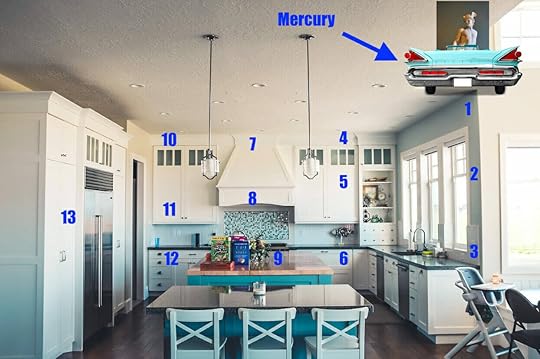
You then simply repeat the process, using simple pegword associations throughout the room you chose.
The Hermetic Memory Palace For the Classic Solar SystemRecently, I wanted to memorize the solar system as it was used in the Italic Hermetic Tradition.
Or better said, I adapted it in a particular way for one of my applied memory experiments.
(See David Pantano’s The Magic Door for the source of my inspiration.)
To do this, I memorized the seven classical planets using my body as the Memory Palace.

The Body Memory Palace for Memorizing the Classical Solar System
Using the human body as a mnemonic device for the planets and information about the solar system is easy.
In this case, I needed only seven stations.
Saturn (the space above my head)Jupiter (the top of my head)Mars (mouth)Sun (chest)Moon (belly)Mercury (hip joint)Venus (thigh)To add more planets, you would simply create more stations.
You can also link each of these stations to numbers using the Major Method. I talked about this style of Memory Palace with memory expert Ron White in this detailed interview.
To add details about the planets is easy once they’re in place. For example, the hermeticists considered Mars an image of willpower. So near my mouth, I imagined this planet clamping my mouth closed to help me hold my tongue as an act of willpower.
Acrostic For The PlanetsTypically, you’ll find examples of planet mnemonics in the form of acrostics.
This type of memory technique involves assigning a word to each letter in an attempt to create a memorable phrase.
Common examples for different amounts of planets include:
My Very Educated Mother Just Served Us Nine PizzasMen Very Easily Make Jugs Serve Useful Needs, PerhapsMary’s violet eyes make Johnnie stay up nights ponderingPersonally, I find all of these mnemonic examples vague, abstract and hard to memorize.
They’re not adaptable either. You can’t easily expand them to include more space for more planets and information as we discover it.
But with a Memory Palace you can.
If you use your body, you can even duplicate yourself inside of a Memory Palace to create more space.

You can reproduce this solar system mnemonic multiple times to help you remember more information about the planets.
This approach uses the Bridging Figure principle taught in the Magnetic Memory Method Masterclass.
The Ultimate Solar System MnemonicIn brief, I think the best mnemonic strategy for the planets is the Memory Palace technique.
If you still like using planet acrostics, you can help yourself remember them better by stringing them out in a Memory Palace. Or you can explore the story and linking method.
In all things, experimentation is important.
And if you’d like to learn more about these techniques, please consider signing up for my FREE Memory Improvement Kit:
It will help you create the perfect system of associations for mastering knowledge of the planets. Both what we know currently and what people thought about the planets in the past.
After all, that’s what true astronomy is all about: the past, the present and what we imagine we’ll discover in the future.
So what do you say?
Are you ready to deeply absorb information about our galaxy?
To infinity!
July 28, 2022
20 Simple Memory Techniques That Work Wonders
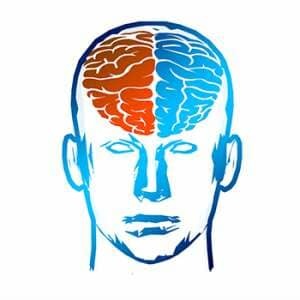 You want memory techniques so you can retain information forever.
You want memory techniques so you can retain information forever.
But you’re overwhelmed by two things:
The topics you’re learningThe vast amount of information about memory techniques themselvesWith so many different terms and unhelpful advice like “use images,” it can be hard to find the best mnemonic techniques for your learning goals.
The problem ends right here and right now.
That’s because on this page I’m going to share every memory technique that exists.
You might think that’s a tall promise. But I’ll show you why it’s true as we go.
And I’ll show you what kinds of information these mnemonic techniques are best suited to help you learn.
That way, you never have to be confused again.
Before you know it, you’ll be a master of your memory.
Ready?
Let’s dive in!
20 Simple Memory Techniques That Work WondersAs we go through this list of memory strategies, they are not compiled in any particular order of importance.
In fact, to get the most of your mind, you can easily plan to learn and use all of them.
Just understand that you don’t have to learn all of them overnight. Pick one or two, and bookmark this page so you can easily find it when you’re ready to add on a few more.
One: Pay AttentionAs memory expert Harry Lorayne often pointed out in his books and presentations, the number one reason we forget is simple. We aren’t paying attention to the information as it comes in.
Paying attention is useful for all kinds of information, and one simple way to practice getting better at it is when you meet new people.
Before going to your next party or event, make a point of telling yourself that you will pay attention to the names of the people you meet. This tutorial will help you .
You can also practice paying more attention as you read. A simple tip is to do a round of progressive muscle relaxation and breathing before using the memory techniques for studying on this page.
I like to sit in a particular way when reading and pretend that I’m “hunting” for details. It helps me pay more attention to the material and pick up the nuances.

Many memory techniques rely upon connecting one thing with another through association.
These associations can be direct or indirect. They can be extremely broad or granular. Either way, the entire strength of this memory technique relies on one simple principle:
Connect (or associate) information you want to remember with information you already know.
For example, a direct association would be meeting a person named Brad and associating him with the actor Brad Pitt. If you do not know Brad Pitt, obviously he would not be an option. Some other person named Brad that you do know would be the better choice.
An indirect association would be memorizing a word in a foreign language or medicine and coming up with something that sounds close enough.
For example, Oliver Sacks does not sound exactly like the sacral plexus, but if you have him crawling the sounds of “Sacks” and “crawl” will trigger the word “sacral” indirectly.
Or, to stick with needing to remember a name like Brad, an indirect association might be to think about brass knuckles or the obscure Skinny Puppy compilation album Brap. Both the words brass and brap are close enough to at least trigger the target information you want to remember.
Why?
Because these choices are based on the sound-association of br in the association and br in the name of the target information.
Three: Use Multisensory MnemonicsA lot of training material on the use of memory techniques confuses people because they use terms like mnemonic images. This teaching makes it sound like you’re supposed to think in pictures.

Some people certainly can do that.
However, when making associations, it’s important to add other sensations to the images. This activity is important because of the elaborative encoding principle I’ll share with you in a moment.
For now, here’s a handy acronym to help you remember the main types you can make: KAVE COGS.
KinestheticAuditoryVisualEmotionalConceptualOlfactoryGustatorySpatialFor example, if you have to memorize a last name like “Hamilton,” it’s okay to imagine ham. But you’re much more likely to remember it if you think about how a big slab of ham feels in your hands (and make it weigh a ton).
Then, go further. Imagine how it tastes and smells. Think about how big it is. Imagine having an emotional reaction about it, such as feeling sad that you’ve dropped it on the ground. Hear the sound of it falling.
You’ll want to use these aspects of multisensory association frequently. Keep KAVE COGS in mind because it’s tremendously useful for many of the other memory improvement techniques below.
Four: Use A Visual AlphabetPeople have been using memory techniques for thousands of years. And as Lynne Kelly has shown in Memory Craft, having a visual alphabet has been profoundly useful to many people throughout history.
Using a mnemonic device like this lets you rapidly draw upon associations you’ve created in advance.
That way, if you come across something like “sacral plexus,” you’re not fishing around in your mind for the perfect association. You’ll already have something that is close enough to at least kick off the association process.
There are many kinds of visual alphabets that a wide variety of memory trainers have taught:
The pegword method as popularized by Bruno FurstThe Tree List taught by Kevin Trudeau in Mega MemoryThe Sun List as taught in Jim Kwik’s memory course“Mental Lego” as taught in the Magnetic Memory Method MasterclassThe Composition of Images as taught by Giordano BrunoSEM3 as taught by Tony BuzanThere are likely many more names that people have given in their memory improvement books and online memory courses.
The trick to developing your own visual alphabet is to simply write out the alphabet and think of people, objects and actions you’re already familiar with.
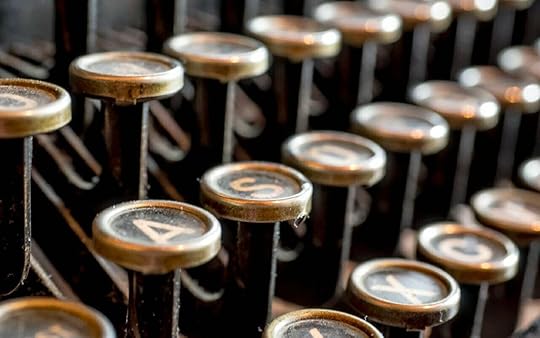
To make them really alive in your imagination, apply KAVE COGS to each and every one. Remember: all memory techniques are a lot more powerful when you make your associations multi-sensory.
Five: Word DivisionWhen you start applying your visual alphabet to memorizing information, you’ll sometimes need to memorize long and complicated words.
It’s much easier to apply a visual alphabet to such words by breaking them apart and applying associations one syllable at a time.
For example, the word “triskaidekaphobia” (fear of the number 13) can be broken down in a variety of ways.
Exactly what ways will work best for you requires experimentation. Here’s how I did it:
Trisk (to associate with a trisket)A backdoor patio (a.k.a. a deck)Phobia was already known to me, but you could use a phone, Phoebe from Friends, etc.Notice that the technique is omnidirectional. Sometimes you can be direct, as in using a trisket to represent the trisk sound.
Other times, you have to be indirect, or use an object that has multiple possible terms, such as a patio that can also be called a porch, deck, balcony, etc.
The key is to add in KAVE COGS to make the associations multi-dimensional.
Six: Etymological AssociationSo far, I have been giving examples that are mostly direct or indirect.
But you can also use the main memory technique of association in an etymological way.
Let’s stick with our triskaidekaphobia example a bit longer.
If you have some skills in this area, you could also notice conceptually that “tri” is in the word “triple.” And that can help you remember that a 3 is involved in the meaning of the word.
The “dek” in triskaidekaphobia may remind you that our word for 10 descends from the Indo-European root dekm-. 10 + 3 is 13, so you think at this level to help remember the 13 part of the target information.
Of course, this tactic assumes that you have some knowledge of how language works.
But several professions rely on some understanding of word origins and you can use a quick analysis of words to help you derive stronger associations. And spending some time studying linguistics is a good thing for everyone to do.

In terms of memorizing this term with the best possible mnemonic, try modeling something like this:
Have a famous person named Tracy riding a tricycle while eating a trisket on a deck.
Next, to make the mnemonic even more effective, imagine this:
Tracy Chapman balancing her tricycle on a skateboard deck instead of a porch deck. She is screaming in fear of the number 13 to help you remember the meaning of the word. This image is weirder and much more memorable as a result.
Seven: Extreme ElaborationI just mentioned Tracy Chapman balancing a tricycle on a skateboard deck to help memorize a word.
Another memory technique is to exaggerate the image. The scientific term for exaggeration in the art of memory is elaborative encoding.
The stranger you make the image, the more memorable it will be. Adding KAVE COGS is a fast and easy way to elaborate the image and I have some elaborative encoding exercises for you here.
But there’s an element of “know thyself” to this practice. You need to know what’s weird and leaps out to you. Different people experience their imagination with varying degrees of sensitivity, ranging from aphantasia to hyperphantasia and even various types of synesthesia.
The more you explore your imagination, the more you can use it as a highly refined tool. You might not use elaborative encoding to the same extreme as others, but it is important for you to experiment with it so you can discover what will work for you.

So far, we’ve discussed various ways to think about associating information we want to learn with ideas, images and objects we already know.
There’s a problem with association on its own, however. When you start making associations, even very strong ones, they wind up floating in the void of your mind.
Sometimes, this presents no problems whatsoever.
More often, however, you wind up facing two issues:
You cannot “find” your associations when trying to remember the target informationYou cannot scale the amount of associations you make efficientlyBoth of these problems were solved long ago by our ancestors who came up with location-based mnemonics.
This is a meta-level form of association where you associate your strange, weird and multisensory associations with locations in space. Many different terms have arisen for this technique:
SonglinesMemory Palace (see these examples)Memory CastleMind PalaceJourney MethodRoman RoomMethod of lociHouse list Files (see Ron White)Body memory Palace (also Ron White)Memory SpacesLukasa (a.k.a. Memory board)Hand Memory Palace (see Tyson Yunkaporta)And there have been many more names in English and other languages. One of my favorites is “apartments with compartments.”
But overall, I prefer “Memory Palace.”

The technique is simple. There are at least two ways you can use the technique.
First, let’s say you imagined Tracy Chapman balancing a tricycle on the decks of 13 skateboards. If you have a deck (as in a patio or balcony), you could place this mnemonic in that location.
Then, instead of having to only search for one part of the mnemonic to get you back to triskaidekaphobia and its definition, you have the place plus the location to draw upon.
This is a weaker form of the Memory Palace technique, but I use it some of the time.
The second, much more powerful version is to have a Memory Palace Network. By having a number of Memory Palaces set up in advance, you’re able to save time, scale the amount of associations you can assign and readily find.
Even better, you can use a process called Recall Rehearsal that helps usher the target information into long term memory very quickly.
Indeed, the Magnetic Memory Method has helped many people use both the Memory Palace Network and Recall Rehearsal to remember many things. I’ve compiled many of their experiences with this blend of memory techniques here.
Does This Memory Technique Really Work?In a word, yes.
Using the Memory Palace technique or any of its variations isn’t for everyone. It requires a bit of setup and some people aren’t willing to put in the time to learn and practice it, even though the benefits have been demonstrated many times by scientists.
Some scientific studies you might want to read include:
Durable memories and efficient neural coding through mnemonic training using the method of lociAustralian Aboriginal techniques for memorization: Translation into a medical and allied health education settingMnemonic Training Reshapes Brain Networks to Support Superior MemoryThe latter scientific article was co-authored by neuroscientist and memory champion, Boris Konrad.

The Recall Rehearsal process I just mentioned is an advanced form of spaced repetition that does not use an app. In fact, your mind and your Memory Palaces are the app.
But you can also use:
FlashcardsSoftware like Anki and Traverse3x World Memory Champion and medical professional Alex Mullen says that approximately 25% of what he memorized for school involved combining Anki with the kind of elaborated associations explored above.
Notice that Mullen is not talking about Anki on its own. That would be rote learning. Spaced repetition works best when you avoid using it to repeatedly show yourself the information and use active recall instead.
Ten: Active RecallActive recall is related to everything we’ve already discussed, with a few nuances worth paying attention to.
It is a process where you deeply personalize what you’re learning and make sure that you bring variety to the game.
Using mnemonics as we’ve discussed is the fastest and easiest way to personalize the learning journey. And when you use multiple Memory Palaces, you’re getting a ton of variety.
But there’s one more aspect to active recall that matters above all. It’s a process, and here are the steps.
Get a notebook or piece of paperBring to mind the memorized information through actively questioning what you learnedWrite it downThis specific process has been shown to help more students with greater accuracy levels.

Now that you know about association, location-based techniques and spaced-repetition, let’s talk about memory techniques for dealing with numbers.
These approaches are related to the systems for memorizing words, but operate a bit differently.
There are a few of them:
Number Rhyme SystemNumber Shape SystemSymbol system for mathematical functions and operatorsMajor System00-99 PAO SystemThe Ben SystemDominic SystemThe Shadow System (discussed here with Braden Adams)I personally use a combination of systems for different purposes. The only ones I don’t use are the Dominic System, the Ben System and the Shadow System.
These feel more complex than needed for my purposes, but some people swear by them, particularly memory athletes.
There’s lots to love about having numbers systems in your toolbox. Let’s look at why next.
Twelve: The Magnetic BookmarkOnce you’ve decided on your number system, you can readily use any page number to memorize some of the content on that page itself. This is an alternative to my main textbook memorization tactic.
Even if you read digital books, you’ll be able to use the location number to use this technique.
Let’s say you find an interesting fact you want to memorize on page 92. If you have images for numbers, maybe you have 92 for Peter Pan (because in the Major System 9 is a p and 2 is an n).
You can now associate that fact with Peter Pan using the memory techniques described above. With this technique, you’ll probably want to limit your use to 3 facts per page.
On the one hand, this doesn’t sound like a lot of information. However, look at this way:
If you can’t memorize 3 things, you won’t be able to memorize 300.
Plus, you can use the technique in real time without having a Memory Palace prepared in advance.

In many of the Renaissance, Medieval, Roman and Ancient Greek memory instructions, you are taught to place a golden hand on every 5th station.
This simple tactic helps you remember key parts of the journey. And if you’re remembering a list, you can work out what number each item is by doing a bit of simple math.
However, why not use a 00-99 PAO to easily know the number of every station in your Memory Palaces? This technique is especially powerful for memorizing scripture, poetry or philosophical texts where it’s useful to know the line or section numbers.

This pre-numbered Memory Palace example shows you how I prepared to memorize the Atma Bodha in full. I know the text and the number of each verse in this ancient Sanskrit text thanks to this memory technique.
Fourteen: Strategic CopyingSometimes memory isn’t the problem. Understanding is.
For example, charts and diagrams can often be difficult to remember because you haven’t quite comprehended the data.
In this case, it’s useful to copy out the graph or chart in your own hand. This is a trick I learned from Tony Buzan at one of his ThinkBuzan events.
Using multiple colors can also help you bring diagrams to life in your imagination.
Fifteen: Mind MappingTony Buzan originally taught mind mapping as a memory technique, but abandoned this aspect in favor of mind mapping for creativity and planning.
I’ve often thought that this decision was premature.
In reality, any mind map can be a Memory Palace provided you use it strategically. One way to do this is to use a maximum of twelve spots on the mind map, as if it were a clock.
Here’s a clock and several other mind mapping examples. They will give you an idea of the options you have when it comes to remembering more through mind mapping.
Sixteen: InterleavingInterleaving is a fancy word for “switching things up.” Except instead of randomly closing one book and picking up another, you do it strategically.

There’s scientific proof that interleaving works, and I practice it within tightly defined study clusters.
For example, at the moment I’m studying Qigong, a special topic in music, the history of detective fiction and logic. I read for relatively brief blasts of time in one book before switching to the other.
The breaks in between promote diffuse thinking and give the brain time to percolate the ideas and make connections between topics on its own.
Seventeen: Tell StoriesAnytime you want to remember something better, you can tell yourself the information in the form of a story.
If you’re trying to remember a legal precedent, for example, translate the dry language of the case into a more vibrant scenario in your mind. Imagine the individuals involved in the courtroom and in the situations that led to the case in the first place.
You can also combine the story method with linking and place what you’ve come up with in a Memory Palace.
It can also be helpful to combine details you want to remember with the stories of movies and novels you know well. Or you can import characters from stories you love into the pages of boring textbooks by using the Magnetic Bookmark technique.
Eighteen: JournalJournaling has been shown to improve working memory.
Even better, it can help reduce negative thoughts and worries that prevent you from paying attention properly in the first place.
It’s possible that seeing ideas in your own handwriting activates a level of visual memory that aids in both short term and long term recall.
Nineteen: TeachThey say that when you teach something, you learn it twice.

Teaching is a great memory technique for precisely that reason. But it also deepens your understanding and enhances your sensitivity to the nuances.
You can keep teaching relatively simple too. By simply explaining to at least one other person something you’ve learned, you’ll remember it better.
And if you can’t find someone to talk with for these purposes, you can also explain it to yourself.
In fact, teaching yourself also connects with the Feynman technique, a means of guiding yourself while learning.
Twenty: Activities That Supplement Memory TechniquesFinally, there are a number of things you can do to make sure that memory techniques work better for you.
These tactics work because your mind and memory is the product of your brain. The healthier your body and brain, the better your memory will work.
All you have to do to get more out of your brain is:
Eat foods that improve memoryLimit injuriesSleep properlyGet enough exerciseBe social as often as possibleAvoid digital amnesiaGet regular brain exerciseUse neurobicsLearn languages

So there you have it:
A masterclass in twenty memory techniques you can use to boost your knowledge of any number of topics. In fact, I’ve covered each and every possible information type in this post:
WordsNumbersSymbolsImagesAlthough all of these techniques are simple, simple doesn’t mean easy.
Don’t be a dabbler, or someone who burns through a list and says, “that’s nice, but too much work.”
That’s how people miss out on the mastery of their memory.
Be the person who spends some time with each and every technique.
Really understand their ins-and-outs.
Apply them to multiple kinds of information.
Want help learning more? Get my FREE Memory Improvement Course now:

If you were to spend just two weeks with each technique, within a year, you would have learned enough to be an expert in any topic you choose.
You have to realize that your memory is much more than just a sponge.
It’s a launching pad that can help you navigate the rocketship of your mind to realize all of your dreams and fantasies.
And the only person who gets to pilot that rocketship is you.
These techniques can be your rocket fuel.
Make it happen. Your future self is counting on you.
July 20, 2022
Everest Memory Masterclass: Is Nelson Dellis’s Course Good?
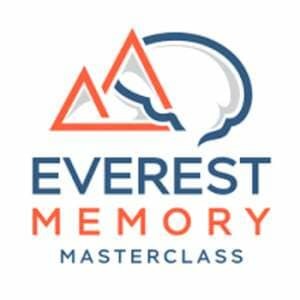 Put simply, Nelson Dellis is a legend in the memory competitor world.
Put simply, Nelson Dellis is a legend in the memory competitor world.
He’s won the USA Memory Championship a bunch of times, and ranks very high globally.
Nelson’s also well-known as a mountaineer. Just about every year, he’s got cool posts of traveling to Everest and other mountains on his Instagram.
But what you probably don’t know about him is that he’s a skilled university lecturer too.
And when memory expertise, the mindset of an athlete and raw teaching ability combine, you get an amazing memory improvement course.
Although I know a fair amount of memory techniques, I learned new things. I had a lot of fun too.
Even better, an aspect of my memory improved.
And just so you know, I didn’t get this course for free. Even though I’ve known Nelson for many years and probably could have asked for a comp, I bought it as a regular person.
To me, that’s important for a few reasons, ranging from instilling the desire to go through the course and feeling free to speak my mind about the experience as a legit course participant.
So if you’re ready, let’s dive into a bit more about Nelson himself, and then the course.
https://www.youtube.com/watch?v=zMyId...
Who is Nelson Dellis?Nelson’s memory competition record is impressive. There’s a full rundown on his Wikipedia profile, including the records he’s broken.
How did it all start?
In response to seeing his grandmother’s memory decline due to Alzheimer’s disease.
I find his charitable and educational efforts especially impressive. I’ve interviewed him several times on the Magnetic Memory Method Podcast and he’s always dreaming up new ways to inspire people to use mnemonics.
His books include:
Remember ItMemory SuperpowersAnd now there’s his Everest Memory Masterclass.
Let’s have a look at what it’s all about.
Everest Memory Masterclass Review: What You Need to KnowThere are many things to love about this course. If I were to sum it all up in a simple statement, it’s this:
Nelson’s very upfront about the fact that each of us need to develop our own skills.
Literally, no one else is going to do it for you. The same way that no one could ever climb a mountain on Nelson’s behalf.
In other words, there are aspects to the art of memory that can only be learned by doing.
With this learning requirement in mind, Nelson equips you with materials that will help in just about every possible regard. He gives you the ropes, the boots, the helmet, flashlight, etc.
You just need to bring yourself and your willingness to take action.
The course includes:
Clear and crisp descriptions of the core memory techniquesWeekly assignments“Memorize with Me” timed sessionsSitdown sessionsLive streams during the cohort (with replays)Discussion groupAdditional resourcesInstructions on tracking your progressProgress testsDetailed lessons on how to beat Nelson at a memory competitionInterviews with renowned memory experts

The progress tracking techniques are probably my favorite part of the Everest Memory Masterclass. Nelson shows you how to set specific benchmarks based on your baseline.
When I took the course, I created my own Google Drive folder as Nelson recommends and started tracking my progress with memorizing words using the International Association of Memory software.
Normally, I memorize directly from print books. So it’s quite something that Nelson’s course encouraged me to tackle something I not only dislike, but dread: memorizing from screens.
Incredible Progress Tracking LessonsAs an example, he gets you to answer some questions and set up folders to track your progress based on the different information categories he teaches.
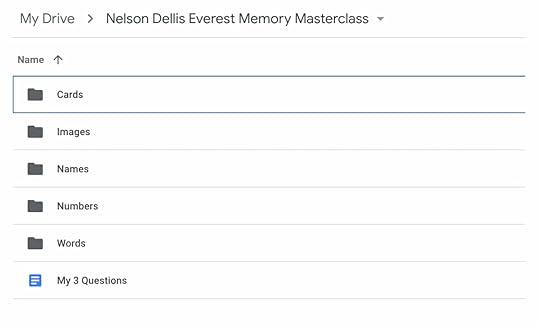
To take you inside just one of my folders, you can see the progress using Nelson’s approach created for me at a glance.
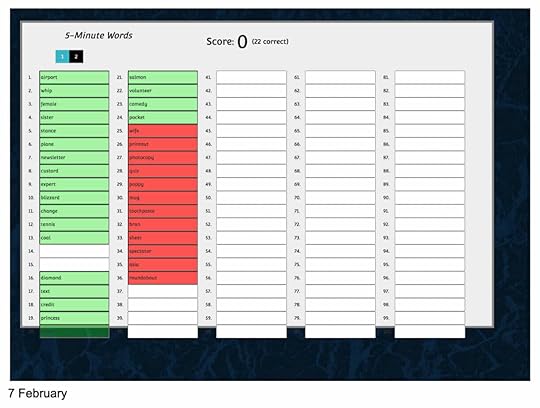
In just one day I went from having a ton of errors to having much fewer errors in the same allotment of time for memorizing vocabulary.
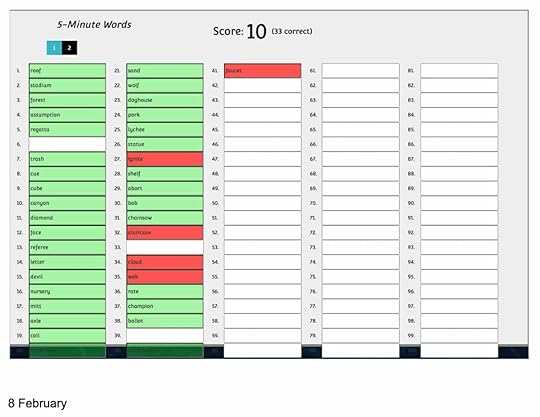
Frankly, I still find it challenging to memorize from screens.
But the proof is in the pudding.
If you track your results, a certain kind of magic as profound as the memory techniques themselves takes place.
And I’m now much better at this particular kind of memorization.
In sum, measuring our own progress is itself a skill. And Nelson’s approach to getting yourself serious gains in this area is fantastic.
The Memory TeachingNelson is an incredible teacher. He gives you multiple ways to think about the techniques and “for instance” examples of how you might use them.
He’s also great at helping you develop the mindset needed to get out there and use them without worrying about making mistakes. He also gives useful tips on getting out of your own way and removing unhelpful self-criticism.
Speaking of criticism, you might be wondering if I have any…
Not really.
But let me gesture at something I think about a fair amount when it comes to online education:
My favorite parts of the course are the longer videos. I find the shorter videos anywhere fairly annoying. I’m totally biased in this regard, and it could have more to do with my demographic than with digital amnesia.
See, I’m in my mid-forties and grew up with detailed introductions to just about everything. The university lectures I attended and gave were usually 90 minutes with (maybe) one break. And my favorite online cases tend to be long.
(I mean, really long and I find that quite helpful compared to short lessons.)
But you know what?
This kind of criticism doesn’t matter much because Nelson’s course has plenty of variety.
Although I couldn’t attend any of the live sessions due to my time zone, I was able to ask him a few questions in the discussion group. And reading the comments and questions of others raised quite a few interesting points I hadn’t thought of before.
And the replays are there if you want them in all their lengthy glory.
The Truth About Succeeding With Any Memory Improvement CourseFrankly, no matter how you cut up a course, the true student goes through it all. The true student develops patience for the many different kinds of content and presentation styles out there.
And when it comes to memory, your results will only partially come from consuming “content.”
The lion’s share of developing your memory will come from taking action. When it comes to memory techniques, there are at least three kinds of action:
Developing your systems of associationApplying them while learning in real timeUsing some form of recall practice to instill information in long term memoryI’m very impressed by what Nelson has put together, especially the detailed walkthroughs. You join him as he explains exactly how you can achieve his same memory feats in detail.
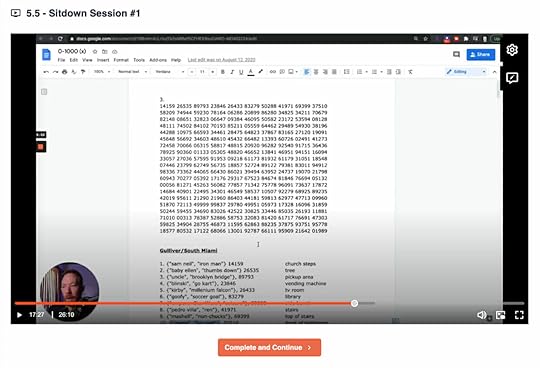
And if you find it hard to settle down and focus on your own, the timed focus sessions will be a boon for you. You’ll have a focused set of sessions to sit down with and get the implementation aspects of the course done.
Yes, You Should Take Everest Memory MasterclassIn sum, this is a great course and you should take it.
Frankly, if you go through everything and take action, your memory will improve.
In my experience, the hardest thing for most people is setting goals for what to memorize.
Nelson has pretty much solved that.
No, you might not want to memorize random vocabulary or digits.
But the fact of the matter is that the world is filled with them.
And if you can’t remember them as they come in randomly, you’re probably not going to be able to memorize them when they’re packed into meaningful units.
So in this program, you get the best of all possible worlds.
It’s just up to you to take the steps. Or place your hands on the mountain face, as the case may be.
And on that note:
I’ll never forget something Nelson told me during one of our many conversations.
He said that when you’re climbing a mountain, you don’t have to worry about the peak.
It’s there. And you can reach it.
Really, all you have to think about is where you’re going to place your hands and feet next.
When you’re willing to do that, you can summit the biggest mountain of them all:
Your mind.
So what do you say?
Are you ready to experience epic memory skills?
I can’t recommend Everest Memory Masterclass highly enough!
July 6, 2022
How to Improve Memory After a Stroke: 4 Proven Methods
 Many people come to me with memory loss after a stroke.
Many people come to me with memory loss after a stroke.
They’re confused.
Struggling to pay attention.
Frustrated that they can’t remember details that used to come to mind so easily before suffering their stroke.
Equally troubling are the spouses who email me about their loved ones.
They ask me about brain exercises for stroke recovery.
And they’re generally worried about the future, because we all want to lead rich and fulfilling lives in our old age.
Which won’t be easy or particularly fun without enjoying significant recovery.
Good news.
Life can be rich and fulfilling, even after a stroke.
On this page, you’ll learn all about why memory loss happens after a stroke.
And what can be done to get your precious memory abilities back.
Not only that, you’ve got a chance of having your memory operate even better than before.
Ready?
Let’s dive in.
Does a Stroke Cause Memory Loss? What You Need to KnowStrokes cause memory for a few reasons.
Brain cells die as a result of the strokeNeuronal connections may be severedVascular dementia may developComorbidity or other health issues may exacerbate the previous reasonsThere are other factors that might contribute. For example, researchers have found that previous educational experiences might contribute either positively or negatively.
In other words, if you have a strong education background, you may fare better than someone who has not. Likewise, if you’re bilingual, you may have developed “cognitive reserve” that will work to protect your brain.

To be clear: learning a language or completing a degree might not prevent you from having a stroke. But it can help protect your brain from damage, or bounce back much faster.
Of course, a lot depends on exactly where the stroke has hit the brain. For example, a stroke that affects the prefrontal cortex can diminish your ability to pay attention. This cognitive ability affects memory differently than other types of memory.
Finally, you should know that having a stroke creates stress. Stress is known to reduce your memory abilities.
This means that both the stroke victim and family and community members may be affected.
But the good news is that there is a lot you can do to improve.
Let’s check them out!
How to Improve Memory After a Stroke: 4 Scientifically Proven MethodsThe following list is in no particular order of importance.
All of them are good.
And all of them can be done after a stroke to enjoy memory recovery.
But they also can be done beforehand to prevent having problems in the first place. You’ll enjoy fewer memory blocks and greater brain health overall.
One: MovementResearchers have noted significant memory improvements when stroke patients engage in the 8 brocades of Qigong.
I practice these myself and notice great memory boosts. I recommend Mimi Kuo-Deemer’s Qi Gong and the Tai Chi Axis. It contains easy to understand instructions for each of the movements tested in the brocade study.
Movement also improves sleep, which automatically leads to improved memory.
Two: Vibration WorkIf Qigong gets the entire body movement, transcranial direct current stimulation has been shown to improve audioverbal memory in stroke patients.

These devices can be quite expensive, but there are two alternatives you can explore:
SingingChantingThere are many studies that show the therapeutic value of these activities. My favorite studies come from Dr. Gunter Kreutz and his team because they also show improved mood in their subjects.
In their studies, singing as part of a choir. This outcomes makes sense because being with others also promotes better health.
But it’s how singing and chanting “vibrate” the brain that most strongly correlates with the findings from studies in transcranial current stimulation.
Three: Brain ExercisesThere are all kinds of apps selling “brain exercise” subscriptions. According to Dr. Christine Till and many others, the claims they make are mostly dubious.
So what counts as simple routines that do work?
First, you need brain exercises that follow the mental workout rules shared here. These include new learning, which as we saw above, helps people avoid memory loss from strokes in the first place.
Second, if you want to clear brain fog after a stroke, you need a brain exercise that is designed for such outcomes. Neurobic exercises provide excellent routines for that.

I’ll give you a few specific brain exercises a little further down this page. But first, let’s talk more specifically about what you can do to recover your memory moving forward.
Four: Memory ExercisesMemory exercises differ from brain exercises. Whereas brain exercises train our focus and attention, memory exercises are all about improving recall.
One of the best things you can do is deliberately remember information. You can engage in activities like:
Remembering some of piCommitting vocabulary to memoryDeeply absorbing scriptureLearning a languageTo make all of these activities much more fun and easy, I suggest you learn how to use a Memory Palace. It’s a simple mental tool that uses association to help you learn new things faster.
These Brain Exercises for Stroke Recovery Will Help You Restore Your MemoryNow that you know of the key activities you can explore for better memory, let me share a few quick brain exercises with you.
Give each a try and journal your results along the way.
Writing out your experiences and keeping a recovery diary is the best way to note what works. That way, you know what to do more of and what you can replace.
Number SkippingWhen it comes to improving the ability to pay attention that so that you can remember incoming information, this exercise is key.
https://www.youtube.com/watch?v=p7NPi...
To get started, get from one to ten, but not exactly.
Skip representing the even numbers.
In other words, count “one” out loud, but when you get to the “space” you would normally count “two,” suppress it.
For many people, this will be hard. It’s like saying to someone, “Don’t think of a red cat.” Your mind has to do it in order to obey the command.
But with practice, you can assign space in your mind for numbers without representing them.
I know this exercise is abstract, so please watch the video version so you can learn it as thoroughly as possible.
Kirtan KriyaYou can reduce stress at the same time you boost memory and comprehension.
This simple brain exercise involves reciting simple syllables as you work with your fingers.
Here’s an excellent video tutorial on the practice from Dr. Gary Weber:
https://www.youtube.com/watch?v=ehvok...
If you want a more advanced version of this exercise, try combining it with number skipping.
Memory TrainingWe’ve already discussed a few ways you can train your memory.
But did you know you can also engage in it as a sport?
ACTIVE is the longest study we have, and although it doesn’t involve memory sports as such, it involved using the same mnemonic images memory athletes use.
People who trained with this form of association showed better abilities to navigate life. This included their ability to reason effectively. In other words, by memorizing something each day, the kept their critical thinking skills intact.
Complete Physical PuzzlesDid you know that science shows completing jigsaw puzzles helps your mind age better?
This is likely due to the benefits of haptic memory exercise, literally the mental exercise you get from using your hands. It could have to do with combining the visual and physical experience of assembling a picture in a way that engages Weber’s law.
One study implies that it would be very good if we all continue to complete physical puzzles as kids, rather than playing too much on devices that create digital amnesia. Basically, the study suggests that you’ll do even better with these kinds of activities if you have prior experience with them.
But anyone can benefit, so get yourself a puzzle and start solving it.
Become An Expert And Maintain Your ExpertiseAs we’ve seen, it pays to be prepared in the event of a stroke.
But even if you’re recovering, you can work on developing expertise in a topic and then benefit from maintaining your knowledge.
As Timothy Salthouse has found, there is truth to the “Use It or Lose It” hypothesis.
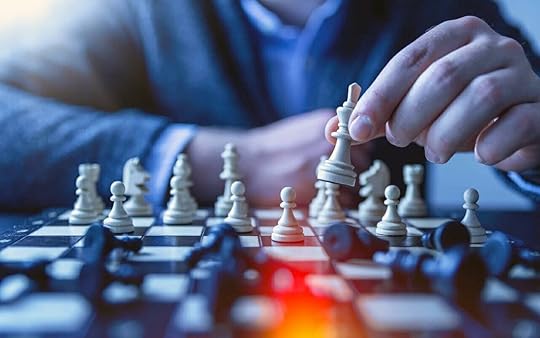
It’s never too late to develop even just a small amount of expertise in areas like:
ChessMusicThe artsLawHistoryLiteraturePoliticsPhilosophyIn all cases, the trick is to get sufficient amounts of deliberate practice.
Can Strokes Affect Memory?In a word, yes.
But so can many other things, both positively or negatively.
So whether you’re working on your recovery now, helping someone who is, or hoping to avoid issues altogether, the time to get started with the activities on this page is now.
The best part is that all of the brain exercises and accelerated learning techniques you’ve discovered today are easy and fun.
So what do you say?
Are you ready to give your stroke the boot and enjoy amplifying your memory?
If so, why not give my FREE Memory Improvement Kit a try?
It will help you develop those Memory Palaces I was telling you about above.
And they’re useful for working on the vocabulary memorization exercises that have been scientifically shown to help people live fulfilling lives, even after experiencing a stroke.
If you have any questions, just let me know and I’ll get back to you a.s.a.p.
June 29, 2022
The Number Rhyme System (What It Is & How to Use It)
 Remembering lists is tough, right?
Remembering lists is tough, right?
Whether it’s items you need from the grocery store or an index of medical terms you need to pass an exam.
Enter the real magic of the number rhyme system.
This simple trick is used by students around the world in multiple fields.
Mentalists use it to create astonishing illusions.
And you can use it too simply by learning it and practicing it with information you want to remember.
The best part?
It’s fun, fast and one of the best memory techniques for kids out there.
Ready?
Let’s get started.
What Is the Number Rhyme System?Number rhymes or counting rhymes are a variation on the pegword method.
That is, they allow us to follow a series of established associations, sometimes called mnemonic images.
Number rhymes are beginner level pegwords, but you can certainly use them even if you are an advanced memorizer.
Typically, they work by rhyming each number to create an object or some other reference. Like this:
Zero is a superheroOne is a gunTwo is a shoeThree is a beeFour is a doorFive is a hiveSix is sticksSeven is heavenEight is a gateNine is wineTen is a henIf you don’t like any of these images, feel free to come up with your own.
For example, some people use a “bun” instead of a gun because they don’t like weapons.
For myself, I switched “heaven” for my friend Evan. He’s much more memorable than that rather vague concept.
That said, if you like heaven, a trick is to make it more concrete, perhaps by thinking about the ceiling of the Sistine Chapel.
I do that for most of these. For example, 3 is a bee is generic. But I make it specific by using Jerry Seinfeld as a bee from The Bee Movie.
How to Use the Number Rhyme SystemThe purpose of this mnemonic system is to “attach” or “associate” information you don’t know what simple mental images.
Then, by elaborating something like a story between the target information and the number rhyme, you’ll find it easier to remember the list of what you want to remember.
For example, let’s say you need to remember that you want to research architecture.
You would then go to your number rhyme system and imagine a famous piece of architecture wrapped up in a bun.

Then, if your second research project is to research steel, you could have steel bars filling up a shoe.
These associations help trigger your memory because of the combination of rhyming the numbers and associating them with the target information.
The cool thing is that if someone tests you: “What was item 5 on your list?” You’ll be able to instantly tell them what that item was.
How to Practice the Number Rhyme SystemWhen it comes to practicing this system, there are a number of things you can do. We’ve already looked at remembering research topics you want to look up in the future.
(This type of use will strengthen your prospective memory, by the way.)
More ways to practice include using the system to memorize lists of:
VocabularyNames of placesBook titlesAnd this mnemonic strategy will work for just about anything that involves simple items or ideas that don’t involve a lot of words. I wouldn’t suggest using this approach to memorize a poem, for example, though you certainly could give it a try.
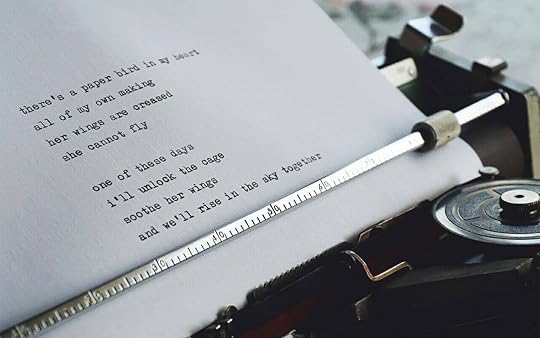
The number rhyme system probably won’t help you memorize a poem, at least not with any ease. But it would make for a fascinating and challenging experiment to try.
The hardest thing for many people is putting the time together to create lists of information to memorize. Here are some suggestions:
For vocabulary, use the dictionaryFor names, use something like the Internet Movie DatabaseFor place names, open up Google Maps and memorize street namesFor book titles, use your bookshelves or Ebook catalogYou can also explore software options like the free International Association of Memory training software.
Expanding From The Number Rhyme SystemUsually, once people have a taste for the power of using number rhymes to memorize lists, they want more.
One of the next levels of skill to explore involves the Major System. It lets you memorize numbers in a highly refined way. Instead of using rhymes, you associate the digits 0-9 with consonants. You then turn these consonants into memorable words.
The Major can be evolved even further by creating a PAO System. Instead of having words to help you memorize numbers, you also use people, actions and objects in a strategic manner.
Finally, the technique that governs them all: The Memory Palace. It allows you to store information in your mind by placing things like rhymes in an imaginary way throughout a building.
For example, let’s say you’re helping your kids learn memory techniques. You know that 2 rhymes with shoe and 4 rhymes with door.
To help your kids remember that 2×2=4, you can use the number rhyme system in combination with a Memory Palace.

If you learn to use the Memory Palace technique strategically, it’s easy to place the entire multiplication table along a simple journey in one or two buildings.
Learn More Memory Systems NowWhat you’ve discovered today is really just the beginning of an incredible adventure you can enjoy using memory techniques to learn and remember more.
If you’d like more information on how these techniques work, register now for my FREE Memory Improvement Kit:
It will show you exactly how to develop a robust Memory Palace Network that scales. You never have to forget important information again.
So what do you say?
Are you ready to master your memory using number rhymes?
Although it’s a simple start to a much larger universe of memory techniques, it will remain useful and powerful for the rest of your life.
June 22, 2022
The 20 Best Philosophy Books Great Thinkers MUST Read
 If you’re looking for the ultimate list of must read philosophy books, welcome.
If you’re looking for the ultimate list of must read philosophy books, welcome.
I’ve been reading philosophy since I was very young, starting with Albert Camus.
In fact, reading Camus at age fourteen is perhaps too young!
It started with stumbling on The Stranger at the local library. It’s a quick and easy novel, but also tremendously profound.
At the back of the novel, the author bio talked about Camus’ work in existentialism, so I went on to read The Myth of Sisyphus and his other novels.
Although I didn’t understand much of his philosophy at the time, it introduced me to an entire world of writing about thinking. I was hooked.
And now I want to share with you my top pics, why they matter and some of the key points that have stuck with me.
Ready?
Let’s get started!
The 20 Best Philosophy Books of All TimeBefore we get started, let’s call a spade a spade.
There’s something deeply unphilosophical about pretending we can make a Greatest of All Time list when it comes to philosophy.
Why?
Because what is true in philosophy is true regardless of the book that it appears in. And any book that helps others discover not only what is true but how to think about and discover truths…
Well, that book is undoubtedly fantastic.
Also, I believe that when we define philosophy to our best abilities, it is something we do. In other words, philosophy is not really reading books. It is creating concepts with an attuned awareness of how our reading influences us.
Case in point, I am influenced by Gilles Deleuze in thinking that philosophy is an act of creating concepts. And as you’ll see, I’m also influenced by ancient thinkers and people like Nietzsche that at some level, we don’t even do that. Rather, philosophy does us.
I’ll explain more of what I mean as we go through this list.
One: Plato’s DialoguesGetting to attend university was an extraordinary opportunity. But it wasn’t until my second year that I chose a major, which at that time was Political Science.
The first reading I was assigned was Plato’s The Republic. It’s an extraordinary read that starts with a memory and takes you not only into deep ideas, but also how to explore them through discussion.
I went to the professor as soon as I was done reading it and asked for more. She told me that Plato had written a ton of dialogues and suggested the Edith Hamilton and Huntington Cairns edition of Plato: The Collected Dialogues.

All of the dialogs are worth reading, but my favorites are The Republic, Sophist, Ion and Lysis.
Lysis was particularly important for me many years later. It has a lot to do with friendship, which is the topic I ultimately wrote my dissertation on.
In terms of core ideas, there’s so much to highlight, and that’s one reason I make this my top recommendation. A major benefit of reading Plato beyond just a few dialogues is that you get to see just how old certain unresolved problems are.
It’s not that there’s “nothing new under the sun.” Rather, you experience just how nimble the ancient mind was and how little our capabilities have changed. Although you would think our current concerns about technology would be very different, the core anxieties are right there back circa 427-348 BCE.
Pro-tip: Take some time to read about the Pre-Socratics. A lot of what you find in Plato is a reaction to what philosophers like Thales, Anaximander, Heracleitus and others had to say about nature.
Two: What Is Philosophy?Let’s skip ahead a few thousand years.
What is Philosophy? is a fantastic companion to Plato for a few reasons.
First, it helps you see how Plato created many important ideas as concepts linked to personae.
These points are important because we often think about truth as something objective. In other words, the truth is true regardless of our opinions about it.
But as Deleuze and Guattari argue, it is science that tries to “freeze” observations in time in order to make truth claims about the world. That is quite like what the Pre-Socratics tried to do and why Plato reacted to them as he did.

Instead, Deleuze and Guattari see philosophy as something intensive and coming into being as one does philosophy in time.
They distinguish their preferred kind of philosophy as immanence rather than the transcendence of Platonic thought.
Rather than respond to the world as if there were some other essential truth or God behind it (transcendence), they respond to being itself (immanence).
In this approach, they are heavily influenced by Nietzsche.
Three: The Gay ScienceFriedrich Nietzsche wrote many books. They’re all important because, as Martin Heidegger shows in his commentary on Nietzsche, he was incredibly consistent across his career. It’s almost as if he knew what he would write in his last book in some of his earliest youthful writings.
I chose The Gay Science for this list because this is the book in which Nietzsche warns us against the harms created by thinking that the universe is someone “alive.”
Rather, we need to accept that things are just here and happening. We don’t necessarily get to know why.

This book also gives one of the most important references to the notion that “God is dead.”
However, as Fred Ulfers pointed out when I studied Nietzsche with him at the European Graduate School, this crude idea is not really what Nietzsche meant to convey.
Rather, Nietzsche was critiquing how we all behave religiously. And if we are going to go around acting ritualistically to our gods or even the universe itself (as if it were alive), then our gods may as well be dead.
This is a very different pronouncement and if you read The Gay Science carefully, you’ll pick up this nuance. You’ll become a much better thinker too.
Pro-tip: The Bernard Williams edition of The Gay Science is especially good.
Four: The AnalectsOf course, Nietzsche isn’t the only person who thought that our capacity for ritual was out of alignment. Confucius focused on this long before he was born.
The Analects often isn’t on lists of top philosophy books because some people think it is merely commentary. And it was also compiled long after Confucius’ death, so doesn’t have an author in the strict sense.
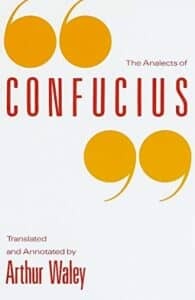
However, as Bryan W. Van Norden points out in Taking Back Philosophy, you find all the important concerns covered by this text. He compares Confucius to Plato for the importance of how the nature of being is discussed as a formal procedure. Conventions are described, interrogated and revised in order to help us live better at the personal and societal level.
Other key points include:
The role of the individual relative to the stateLearning and being a good studentDeveloping and maintaining personal integrityContinual self-evaluation through reflective thinkingLong story short: Don’t miss The Analects.
Pro-tip: The Arthur Waley version looks better on the page than some versions I’ve seen. It also comes with excellent discussions of key terms and useful annotations.
Five: Taking Back PhilosophyAlthough I think parts of Taking Back Philosophy: A Multicultural Manifesto are argued strenuously to the point of excess, at least Van Norden acknowledges this aspect of his style.
He’s clearly passionate about this main thesis: We need to be aware of philosophy from a wide number of traditions, cultures and historical periods. This includes philosophical works from:
AsiaSouth AmericaIndiaAfricaAboriginal philosophyNative AmericanAnd many more.
He makes a compelling case that many traditions have been not only neglected by European thinkers, but also actively dismissed.
However, a weakness of this book is its lack of acknowledgment of European thinkers who have embraced other traditions. Schopenhauer, Nietzsche, possibly Hume, Deleuze and many others not only owe a debt to philosophers from around the world. They embrace them.
Another issue with this book is how the notion of “West” and “Western” is portrayed. Is there anything particularly “western” about some of the most important Greek philosophers? Hardly, given the fact that many of them were from what is now called Turkey.
Nonetheless, I feel that Taking Back Philosophy belongs on your shelf and I’m glad it’s on mine. I refer to it often and it helps me think better about bringing together philosophers from around the globe and throughout history.
Six: The Nichomachean EthicsAristotle is not one of the Greek philosophers who originated from Turkey, even though apparently in 2016, the country tried to claim him.
Most people think that Aristotle was born in Macedonia, but where exactly he is from is not what makes The Nichomachean Ethics so important.
This book is important because it discussed many concepts that are important to us today:
The nature and role of happiness in our livesExamples of the golden mean, such as its role in courageHonestyFriendshipI used this text in particular for my own dissertation on friendship. It was essential reading and Aristotle remains a key philosopher for ideas on how to educate yourself and form solid habits for the good of one and all.
Seven: Atma BodhaNormally, you’d expect a text like the Bhagavad Gita to appear in a list like this.
And make no mistake, I think it’s well-worth reading.
However, there are many texts that have cut out the story and compressed the philosophical knowledge into a much shorter space.
Atma Bodha is one such text.
Some people have also set the text to music, which is useful for memorizing the material if you wish.
My favorite translation of the Atma Bodha is by James Swartz. It comes with his excellent commentary in The Fire of Self Knowledge.
I talk about how I’m memorizing it in the original Sanskrit here:
https://www.youtube.com/watch?v=ViRws...
Why do I think it’s so important?’
I feel that it’s one of the best condensations of the Advaita Vedanta philosophy at the core of Bhagavad Gita.
Pro-tip: Ramana Maharshi also produced a compression of this knowledge in his Upadesa Saram. Comparing both texts is useful.
I’ve also shared my experience memorizing texts from this tradition in my TEDx Talk.
Eight: Sand TalkIn Sand Talk: How Indigenous Thinking Can Save the World, Tyson Yunkaporta shares key points from Aboriginal philosophy you’ll struggle to find anywhere else.
For one thing, he also shares more than just his own cultural knowledge. He digs deep into the ideas of lesser-known philosophers around the world.
Even better, he shares some of the Aboriginal and Indigenous memory techniques anyone can use to remember the philosophical ideas he presents.
The core philosophy in this book involves a particular style of dialogue Yunkaporta calls “yarning.”
It’s an upgrade of the Platonic dialectal style of discussion, yet also predates it. You’ll definitely want to read this book.
Nine: The Evolution of Modern Metaphysics W. Moore has to be one of the most underrated philosophers ever. He’s one of the few analytical philosophers out there who really understands and underscores the value of continental philosophy.In The Evolution of Modern Metaphysics, his powers of clearly explaining core ideas are in full force. He takes you through the key thinkers starting in the Modern era with Descartes up to people who are often dismissed, like Jacques Derrida.
Since I myself have worked to balance ideas from both analytic and continental philosophy, I especially appreciate the depth of thinking and generosity of intellectual inquiry Moore brings.
Pro-tip: His book Points of View is more complicated, but also astonishing. I think he demonstrates his core thesis that it’s possible to think from no particular point of view very well.
Ten: Modes of ThoughtAlfred North Whitehead might not be correct in the end, but in Modes of Thought, you’ll enjoy some of his best ideas and thought processes.
For example, he helps us think about thinking. What’s important and how do we know? What is the nature of understanding? What exactly takes place when we’re expressing an idea?
Philosophical questions like these are tremendously important.
Even better:
Whitehead tackles science and asks us to rethink matter. He sees science as isolating things in time, a point Deleuze and Guattari raise in What is Philosophy? Rather, if change is truly the only constant, then our philosophy must take it into account in a much more integral manner.
By the same token, Whitehead points out the limitations of language and the dangers of relying on it too much. He sees how we use language as one of the main sources of our problems and a key issue with the materialistic worldview overall. Language, like science, causes us to try and “freeze” things in time rather than acknowledging the consistency of constant change.
The best part is that Whitehead often uses stories and anecdotes with references to animals that help make his points clear.
Eleven: Gödel Escher BachAlthough some people won’t recognize Douglas Hofstadter’s epic Gödel Escher Bach as a work of philosophy, I feel that it is one of the best.
It’s about the nature of consciousness with a heavy focus on examples of recursion in computer programming. But along the way, Hofstadter takes care to relate the nature of programming to art, music and our conscious experience of life overall.
Ultimately, Hofstadter sees consciousness as a “strange loop.” And the book is filled with such strange loops, including his excellent meditations on the nature of Zen.
Paradoxically, he later said in an interview, “I hated Zen.” Given how wonderfully he explains the workings of Zen in the mind of the practitioner, I have to believe he meant this in jest.
Twelve: PrinciplesSome readers will mistakenly dismiss books about business philosophy as “true” philosophy.
However, I feel that would be a mistake. Certainly, as a business owner, I’m biased. But it’s clear to me that a business, like every individual and the universe itself, has some kind of being. Businesses exist and we need to philosophize about them.

I chose Principles for this list for a few reasons:
Dalio’s tremendous business successThe structure of the book, which is reminiscent of Spinoza’s EthicsThe multiple layers of philosophyFor example, Dalio divides his suggestions between the nature of the individual entrepreneur, the entrepreneurial team and the business itself as a kind of “machine” operating in the world.
One of his core philosophical ideas is that all business machines are built from multiple moving parts. When conceived of correctly, these parts can be “fine tuned.”
Dalio really is a lot like Spinoza the more I think about it!
Thirteen: Aramis, or the Love of TechnologyBruno Latour took a risk with his wonderful analysis of technology and society by recording his observations in the form of a novel.
Latour introduces Actor-Network theory in Aramis, of the Love of Technology. Although it might seem unusual to deliver a philosophy about how everything is shifting at all times, Plato’s dialogues are essentially stories. And many philosophers have used the format.
If you’re interested in philosophy of science and the notions of pure immanence and becoming, this book is one of the greatest philosophy books I know that experiments with the format.
Fourteen: Striking ThoughtsA lot of people know at least one Bruce Lee quote. It’s usually, “be water, my friend.” Or it might be, “No ego, no enemy.”
These are all great, but like Bruno Latour, Bruce Lee was a philosopher of change and the relations between many things in the world. As he wrote in Striking Thoughts, “to live is a constant process of relating.”

The book is a fantastic study in dealing with constant change as a learner.
But the best part for me is the teaching philosophy. Although it won’t apply to every aspect of education under the sun, Lee focuses on processes that enable students to reach their own conclusions. And that’s including when either teacher, student or both are insecure.
And as many good books of philosophy do, this book includes enriched approaches to ethics. This book belongs on the shelf of every diverse critical thinker.
Fifteen: Discipline and PunishMichel Foucault has been a controversial figure lately. A lot of people who seem not to have read him have co-opted poorly summarized versions of his ideas and twisted them out of shape.
Worse, they made ad hominem attacks against the philosopher himself. Sure, he may have been engaged in some unpleasant things. Many humans are. But that doesn’t necessarily reduce the value of his work.
So what is that value?
I chose Discipline and Punish for this list for two reasons:
The book tracks the historical shift from public executions to private imprisonment and the philosophical ideas involved in the transitionFoucault helps you think about how we as societies surveil each otherFoucault provides a nuanced definition of powerFor these reasons, this book has been so influential, as have many other works by Foucault. You don’t have to agree with him or become “Foucauldian” to benefit from reading it.
But if you do find yourself responding judgmentally, this book might help you see how and why our culture shapes people for whom capricious responses are often the default setting.
Sixteen: On the Shadows of the IdeasThe importance of Giordano Bruno has yet to be fully explored. Many philosophers mention him, including Nietzsche, and his memory techniques remain highly influential.
Part of his ongoing longevity comes from Frances Yates’ portrayal of him in The Art of Memory.
https://www.youtube.com/watch?v=k3GGc...
However, she misrepresents him as a hermeticist. Although he certainly has elements of pantheism in his approach, not dissimilar to Spinoza in his Ethics, I believe Bruno is ultimately a non-dualist.
If you read and even put into practice his conceptions and intentions, you’ll discover that, like the Vedantans, he was essentially working to neutralize or dissolve the notion of the individual self.
Sadly, these ideas are often lost in the discussions of Bruno, who was burned at the stake for the crime of believing in infinity.
Pro-tip: John Michael Greer’s translation is fantastic and we discuss it here.
Seventeen: EthicsSpinoza’s importance cannot be underestimated. In some ways, the best philosophy that follows his Ethics owes him a great deal.
He is a philosopher of unity and becoming, of pure immanence before Deleuze and Guattari cooked up that term.
As Spinoza writes:
“The idea of the mind is united to the mind in the same way as the mind is united to the body.”
By demonstrating the validity of this claim, he ultimately demonstrates a complete oneness between all things. If he’s correct, we all get to experience infinity.
Pro-tip: Steven Nadler’s recent, Think Least of Death is an excellent and accessible discussion of some of Spinoza’s more challenging ideas.
Eighteen: The Classical TriviumMarshall McLuhan is famous for his media philosophy. But none of his explosive ideas would have happened if he hadn’t been a student of how ideas were spread before radio, TV and cinema.
In fact, probably his most important book is his study of The Classical Trivium. In it, you’ll learn how some of the most important philosophers thought and wrote. For example, humanists like Erasmus and Bacon took pains to align themselves with the ancient philosophers. We often think of them as helping birth the modern era, but if anything, they were looking backwards, not forward.
McLuhan shows us how during the Medieval and Renaissance periods, thinkers believed we could read the world and the universe itself as if it were a book. It shows the history of the art of interpretation and you’ll learn about how people in this era structured knowledge. These are reading strategies that are still useful to this day.
Nineteen: Powers of HorrorSome books contain ideas that are impossible to forget.
Enter Julia Kristeva’s Powers of Horror: An Essay on Abjection.
This book helps you think better about a few things.
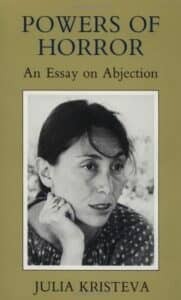
For example, why do you feel separate from everything else? Is it because you’re actually separate, or has your culture trained you to feel and think as if you were divided from the rest of reality?
Kristeva analyzes a number of linguistic codes and social processes, including bodily functions and conventions we’ve created to deal with them.
Sure, these topics are not exactly dinnertime conversation. But going through them with Kristeva will change your life for the better. It’s also essential reading if you want to understand cultural phenomena like the horror genre.
Twenty: How It Is F. Cordova is an excellent philosopher to round out this list. In many ways, she compliments Kristeva’s concerns about differentiation. She shows how it happens to entire cultures.We also find through Cordova’s work a compelling study of Native North American thinking. For example, she shows how individuality is a given, yet always in the context of the whole.
Each human being is given different opportunities to grow their strengths in this conception. They are shaped by a balance of interest in the individual’s ability to help the whole as a group.
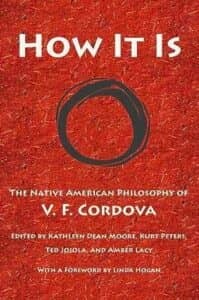
She also talks about our duty to do philosophy, which reminds of Deleuze and Guattari’s insistence that philosophy is about the creation of concepts.
The more we all get together to collaborate on the creation of concepts for the good of everyone, then How It Is will be very good indeed.
How to Choose the Right Philosophy Books for YouI have so many runner-up books I’d love to include, including volumes by:
René Girard for mimetic theoryUmberto Eco for semioticsKitaro Nishida for his work on ZenKey texts by some of the StoicsBut when it comes to choosing the best possible philosophy books, I recommend balancing quantity with quality.
To do this, read in missions.
Remember how I mentioned McLuhan’s study of the Trivium? Well, hidden inside of this style of learning is the idea that you group together a few different categories as you read.
For example, when I was learning Advaita Vedanta, I read two other categories at the same time and used the principle of interleaving. It’s a memory technique that helps you remember more.
So for example, although my core focus was on Advaita Vedanta, I switched in books on Zen and hermeticism.
Then, when that reading cluster was done, I moved on to the next cluster by reading books focused on astronomy, math, geometry and music.
When you read this way, you wind up with a much larger world view, much faster.
Umberto Eco suggested as much in his final letter to his grandson. Eco also urged his grandson to learn how to use his memory.
On this site, I talk about philosophy a lot. But the core focus is to encourage and inspire people to use memory techniques.
In some ways, I’m like what McLuhan thought Erasmus and Bacon were like: People looking at the past for inspiration.
If you’d like to discover what I’ve learned about the ancient art of memory, get my FREE Memory Improvement Kit here:
You’ll discover how to use a Memory Palace.
That way, when you’re reading the top philosophy books you’re interested in, you’ll be able to remember their key points.
Read Philosophy with MomentumThere you have it. My top picks from decades of reading philosophy.
I hope you’ve encountered some reading suggestions you haven’t found anywhere else.
And I’d love to know what you pick.
Even better, I’d love to know what concepts you create after reading your choices as you do the work of philosophy yourself.
Happy reading!
June 15, 2022
206 Deep Philosophical Questions for Smart People
 News flash: philosophical questions for smart people must actually be philosophical.
News flash: philosophical questions for smart people must actually be philosophical.
I raise this point because so many people ask general interest questions and call them philosophical.
But that doesn’t mean that they actually are philosophical.
At its core, philosophy is the investigation of the nature of being.
As Martin Heidegger often put it, asking deep philosophical questions of his own, we need to question the being of being itself. And how is it that we as beings have come to not only ask questions, but question the nature of what it means to ask questions in the first place?
206 Thought-Provoking Philosophical QuestionsWith these points in mind, here’s a list of questions that will help you experience rich and rewarding conversations with friends and family.
I’ve split the questions up into different categories and will sometimes discuss why the questions are so valuable to discuss.
Ready?
Let’s get started.
OntologyAs Dale Jacquette points out in his book Ontology, we often take the question of what exists for granted. What does it mean for something to exist? How does existence relate to things that are merely coming into being?
Ontological questions focus on being and who it relates to the opposite: non-being or non-existence.
Here are some of the most important questions in this area:
Why is there something rather than nothing? What does it mean to exist? What must be true in order for us to say that something exists or does not exist?This question is especially interesting because we talk about many things that technically don’t exist, such as unicorns.

Yet, the very notion of unicorn is premised upon other things that do exist, such as horses and animals that have horns. We can also think about horns in relation to seashells. So with this in mind, is it really the case that unicorns do not exist?
For more on the problem of non-existence and some proofs that non-being cannot be the opposite of being, see Plato’s Sophist.
What laws govern matter? When does life begin?This question applies both to life as such in terms of when it first appeared in the universe, and when it starts following pregnancy. You can also ask to what extent that the universe itself might be alive.
Nietzsche was a philosopher who definitely thought the universe was not alive. See aphorism 109 of his book The Gay Science for an extraordinary warning against such humanization of being.
What happens to us when we die?What is the most perfect form of being?Does a god exist? If a god exists, why would we need to prove this? Is change real or only apparent? What is real?What is reality? Is reality one or many?This question means to investigate not just the nature of one reality as opposed to a multiverse. It is also the question of whether or not everything in the reality is connected, or if there is separation between things.
Is reality material or spiritual? Is reality permanent, or is it itself always changing? If the entire universe is always in motion, can any object ever be at “rest”? Are light and darkness equal?Does history exist or did humans invent it? If so, does it repeat itself? Does the past continue to exist after it is gone? Is the world of tomorrow already here?These last two questions were raised by Einstein and Gödel. For a full analysis, see A World Without Time.

In essence, it is fascinating to think that even though yesterday is gone, the world of yesterday is still there and potentially accessible.
EpistemologyAs Christopher Norris puts it, epistemology boils down to the difference between opinion and verifiable fact. How do we know what we know and by what criteria do we know if that knowledge is valuable?
Knowledge can be about ideas, things, substances or states. Here are a pile of compelling questions you can ask in this area:
What is the nature of knowledge?Where does knowledge reside? In individuals or in humanity collectively? Is knowledge in our sense-impressions? In mental perceptions? In our judgements?What counts as a valid source of knowledge? What are the different sources of knowledge? Is knowledge something that we can possess?What is truth? How do we test what is true? What is a question? What is a good question? Why do some words and phrases translate cleanly between languages while others do not?Can we think something into existence?Can we think something into non-existence?Can we think about things that don’t exist?What is a substance?What is a number?
Do “spirits” exist? If so, do they “know” things? What is a fact?What is an opinion?What is a mistake? What does the fact that mistakes are possible tell us about the nature of reality? If you know what you’re looking for, why would questions about it arise?
If you don’t know what you’re looking for, how is it possible that you have enough knowledge to know that you want to find it? (This is essentially Meno’s Paradox.)
How much can an individual person know? Can an individual ever know anything on their own?This question is very important because language is not owned by any individual. At its core, all knowledge is likely shared by virtue of this fact alone.
What is “language”? Are all languages equal? What makes a justified belief justified? How does language refer to the real world? What is truly objective and not subjective? What is the order in information? Or is it all chaos?What is philosophy?Why is philosophy important? Am I doomed to always be naive?EthicsPeter Singer is one of the most important philosophers associated with ethics. One of his core concerns involves the duties of individuals with respect to the whole.
Within this field, one must consider the maximization of pleasure and the minimization of pain. It’s very hard to balance these two factors without causing harm to some by minimizing pain for others – and this problem explains a lot of the strife and turmoil we see in the world throughout human history.

These questions will help you think through philosophical questions related to ethics.
By what principles do we judge things right or wrong? What does it mean when we say that things “ought” to be a certain way?What are the principles, criteria and standards by which we should decide what to do? Is justice good because we prefer it, or do we prefer justice because it is good? What makes a human being moral? Should you seek to maximize your personal pleasure? Is it right to take on pain for yourself if it helps maximize the pleasure of others? What does it mean to be a good friend? What are my personal responsibilities as a local, national and global citizen? Is there a scientific basis to ethics?Sam Harris thinks that the answer to this question is yes. He defends his answer in The Moral Landscape.What is fairness? What are rights? How would I act if I cared for all life on the planet? How would I act if I considered both the short and long term outcomes of all my actions? How do we know when an authority should be followed? How do we know when it’s right to disobey authority? Is it right to keep a person alive artificially? Is killing always immoral and/or illegal? Should people be allowed to worship in any way they please? Is it right to allow children to determine their own gender? At what age should people be allowed to marry? How should we decide who gets to receive organ implants? How do we determine when death has occured?ReligionOne of the fascinating aspects of religion is that people make truth claims about their chosen faith, yet all chosen faiths are under constant attack. As Mikel Burley has pointed out, this has put all religions on the defensive.

In some ways, this makes religion very similar to philosophy because neither of them are a science. Although philosophy and religion are not the same, they both exist to help us answer the questions that science has yet to address.
And as you’ll see from the following list, it is possible for some religious questions to be philosophical in nature. It basically boils down to looking at the philosophical questions that have come up in both the attacks against religion and the defenses various believers have mounted.
Does god exist?What are the reasons to believe that god exists? What is the nature of a god? Is god the ultimate reality? What is the relationship between an individual and a god? If a god does not exist, is there some other form of transcendent reality? Is it rational to believe in a god? Do you choose your faith or does it choose you? Can you be faithful and still experience doubt? If infinity is real, has god already reached it? If so, how is that possible given the definition of “infinity”? Does heaven exist?Does hell exist? Is it right for a god to create and/or allow harm for any reason? If god exists, why is there evil in the world? Is god supernatural, or at one with the universe? Is religion philosophical? Does any scientific evidence validate any religion?Are all religions fundamentally the same? Why do different religions exist? How do we evaluate different religions? Why do so many religions rely upon stories instead of facts? If religion is real, why do atheists exist?Is it possible for an atheist to have a religious or spiritual experience? To what extent do moral positions have religious significance? Is morality pointless without religion?Do science and religion conflict with one another?Anthropological Philosophy
Anthropology has to do with people and their environments and how this relationship leads to the formation of thoughts, beliefs and behaviors. One of the greatest philosophers in this area was Friedrich Nietzsche, who sought to understand how humans create their own values. He was especially puzzled by how humans failed to see that they are the creators of their own values in the first place.

Some people have thought that you actually can measure happiness. Jeremy Benthem’s felicific calculus is one strategy.
How do you control your own happiness?For whom is happiness possible?Is the pursuit of happiness self-defeating? When does seeking happiness make you unhappy?How do you find happiness with others?Philosophy of Art
Can art be defined?Do artists, consumers or institutions like galleries and museums get to define the meaning of art? What media belongs to art and what doesn’t? (Film, literature, cinema, etc.) Why do certain artists resemble one another while others couldn’t be more different? What is it about art that causes a response in humans?What are the different kinds of responses to art? Is the value of art in the work or in the mind of the beholder? Does art have a purpose, or is it an end in itself? What is an authentic performance of a musical piece?In Philosophy: The Basics, Nigel Warburton wonders how we could ever experience Bach authentically without a time machine? Is a high quality forgery still art? What is an artistic style? How do we know one when we see it? What do the cinematic arts teach us about the nature of time?Political PhilosophyPlato believed that societies can be harmonized through political philosophy. He suggested an aristocracy would be best, and had some ideas we might think crazy now. For example, artists and poets would need to be expelled altogether because their representations bent reality.

Ironically, one of Plato’s stories, the Allegory of the Cave (found in The Republic), forms the basis of The Matrix, one of the most popular movies of all time.
Here are some of the most compelling questions from political philosophy.
What is equality?What is freedom?Are equality and freedom reasonable goals? How can they be achieved? What can justify the limits on freedom enacted by the state? Should money be equally distributed? What does it mean to “deserve” something without having “earned” it? Why do different people have different needs? Why does discrimination arise? Since voters typically cannot become political experts, is their voice really valid? Is there a right to freedom of speech? Should people be allowed to lie and/or misrepresent the truth? How can we protect the innocent from punishment?Philosophy of ScienceAs James Ladyman points out, many aspects of life do not change. Most people still work very hard just to survive. Yet, we’ve never had more access to technology than ever before, all thanks to the advancements of science.

It’s not just that science has given us miraculous tools like phones that take high quality photographs. Science has also helped us figure out how to ship them around the world and link them to satellites flying above our heads.
It’s questions like these that have made it all possible.
What is science? What is an experiment? How do we know if the results of an experiment are valid?What are the limits of science?How far might science actually go given enough time and resources?Are there any limits to the problem-solving capacity of computers? Will progress continue on into infinity? Are there any problems with the empirical method? What is the nature of information, data and evidence? How do we know that our tools of detection provide accurate and precise information? Was math discovered or invented? Is a final “theory of everything” possible? If scientists determine that something should be done but people reject it, is it right to impose science upon them? Are there a finite or infinite number of questions for science to tackle? How should we understand universal cosmological time? What is life? What is the nature of a living system? What is the difference between a living system and the matter described by physics? Does life have a goal? If science shows that something is true, are we obliged to use the result? What should we do when scientists break the law or lie?How to Remember Good Philosophical QuestionsI hope you’ve enjoyed this list, even if it includes some unanswerable philosophical questions. That’s just the way it goes with many intellectual questions, and it’s great brain exercise to at least try and answer them.
One problem people face, however, is that they come across good philosophical questions, only to forget them.
If you’d like to continue enjoying the benefits of deep thinking, learn now to memorize as many philosophical questions as you wish with my FREE Memory Improvement Kit:
Many of the best philosophers and deep thinkers have used the techniques I talk about in this course to reflect on deep philosophical questions about life.
And because of how the techniques work, they remembered their answers too.
Happy questioning and leave a comment below if you’ve got questions that belong on this list.
June 8, 2022
Mnemonic Images: What They Are & How They Help
 Mnemonic images are powerful tools learners use to speed up the remembering process.
Mnemonic images are powerful tools learners use to speed up the remembering process.
You can use mnemonic pictures for nearly everything:
Language learningInfo from textbooksChemistryMathNamesFactsHistorical datesListsVerbatim tasks like quotes and speechesThe trick is to assign your mnemonic images correctly.
Miss just one step, and the process can be slow, boring and not worth the time.
But learn to use mnemonic images well, and you’ll learn at a much faster pace.
Ready for the real deal when it comes to this powerful learning strategy?
Let’s dive in!
What Are Mnemonic Images?Mnemonic images are associations.
For example, if I want to remember a name like “Bruce,” I might think of Bruce Wayne from Batman lore.
You attach a simple image like this to information you want to learn.
They can be simple and direct like Bruce Wayne, or more complex as needed. For larger learning projects, we typically place our associations in a Memory Palace.
You can also draw them out, which I often do to speed up the learning process. Here’s an example from one of my language learning missions:
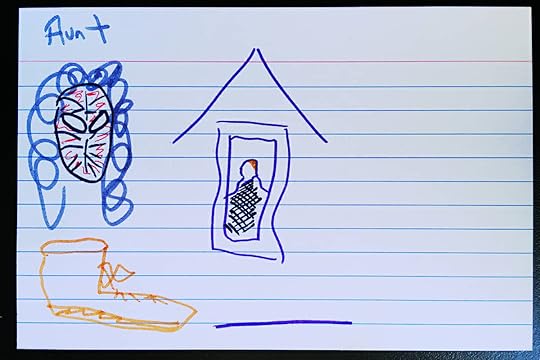
This kind of visual mnemonic works because the answer isn’t on the card. Instead, it presents a puzzle to be solved
And solving it makes memories form faster.
The Truth About MnemonicsFrankly, there’s a bit of a problem in how we use this term “mnemonic image.”
You see, the idea of an image mnemonic makes it seem like the associations have to be visual.
But visual mnemonics are actually just one category of associations you can assign.
In the Magnetic Memory Method Masterclass, I teach you all the major categories of association through KAVE COGS:
Kinaesthetic mnemonicsAuditory mnemonicsVisual mnemonicsEmotional mnemonicsConceptual mnemonicsOlfactory mnemonicsGustatory mnemonicsSpatial mnemonicsThose are the major eight categories most of us draw upon the most often. But there are twenty more that I teach, and knowledge of these can be useful from time to time.
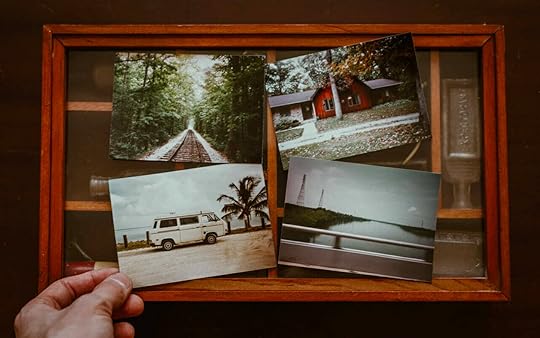
The point is this:
True Mnemonic Images Are MultisensoryGood mnemonic images are always multisensory. They don’t just rely on the visual mode.
So if you want to learn faster and remember more, visual mnemonics are okay. But you’ll do a lot better if you add in more mental imagery based on other sensations. In the Magnetic Memory Method world, we call the range of sensations we use the “Magnetic Modes.”

Why?
Because we know from personal experience and a variety of sources that multisensory association is the key to associative learning.
First, we have thirty years of memory competition records, and I’ve interviewed dozens of memory athletes like Nelson Dellis, Braden Adams, Lynne Kelly, Katie Kermode and John Graham to name just a few. I’ve also interviewed the creator of the World Memory Championships, Tony Buzan.
We know from studies that mnemonic processing works a lot better when it is multisensory. Studies have shown that multi sensory mnemonics can beat flash cards, for example. (I’ll show you a way you can combine mnemonic images with flash cards in a moment, however.)
Overall, multisensory association is a kind of “guided learning,” and this has been shown to be very healthy for adults. And you don’t have to be a memory competitor to benefit. People like myself, Scott Gosnell and John Michael Greer all produce materials for adult learners to help teach themselves this “martial art of the mind.”
With the evidence in tow, let me give you a few steps and some examples that will help you master using mnemonic images.
How to Use Visual Mnemonics to Remember ThingsKeeping in mind that what we’re talking about is visualizing a wide range of sensations when assigning associations, here’s what to do and how to do it.
If you struggle to visualize, try these simple exercises. You can also learn to image stream or develop hyperphantasia.

I know this step sounds obvious, but it isn’t. Many people don’t spend any time at all thinking about what they want to memorize.
This causes issues later because mnemonic images are associations and they can blur into each other if they aren’t separated and arranged in optimal ways.
For example, when you’re memorizing a speech, you may want to memorize the quotes you use first. That’s how I approached my TEDx Talk.
When you’re memorizing foreign language vocabulary, you might want to organize the words by theme or even alphabetically.
Typically, you’ll want to follow the next step to avoid issues that emerge from poor information organization.
Step Two: Use a Memory PalaceYou can definitely use mnemonic images without a Memory Palace. Some people prefer the story and link method.
However, here’s something to consider:
A Memory Palace is a mnemonic image. And it’s a powerful one because it allows you to use every other memory technique within it.

Any building you are basically familiar with can be used as a Memory Palace for storing your mnemonic imagery.
You also can use the Memory Palace to review your mnemonic images. Without this spatial memory foundation, it’s difficult to manage a bunch of associations floating around in the void of your mind.
Step Three: Select Your Mnemonic Images SkillfullyWhen learning, a lot of people make weak mnemonic images.
For example, if they are memorizing scripture, they might do something like this for “To answer before listening, that is folly and shame.”
They might use a mnemonic image of a tutu answering a bee-shaped telephone to get started.
That’s okay, but it’s also generic and vague.
To use the Magnetic Memory Method, you choose much more specific references. I would certainly stick with the tutu, but I would add Desmond Tutu.
Desmond Tutu wearing a tutu is a lot stronger than just the piece of clothing floating around on its own.
Then, with this image secured in a Memory Palace, I would add KAVE COGS. I would literally pretend to be Desmond Tutu and feel the tutu against my skin. I would hear him dancing around like a ballerina on his way to answer the bee-shaped phone.
And it would not be just any bee-shaped phone. It would be the character from The Bee Movie, voiced by Jerry Seinfeld.

These specific references make it easy to pack in sounds, emotions, physical sensations and elements of size, smells and tastes. It’s so much more powerful than visual mnemonics on their own.
Step Four: Review Your Mnemonic Images StrategicallyWith a Memory Palace in play, you’re able to gather together dozens, if not hundreds of mnemonic images. My TEDx Talk involved over 300, to give you a simple example.
(Though, please keep in mind that it’s not a numbers game. And there are different ways to count how many images are involved depending on your exact approach).
In my experience, the best way to review the associations is to follow the Memory Palace journey using dedicated patterns:
Review them forwardsBackwardsFrom the middle of the Memory Palace to the endFrom the middle of the Memory Palace to the beginningOut of orderRandomly pop inThis approach gives equal doses of Primacy and Recency to each mnemonic image in the Memory Palace.
Step Five: ExperimentI mentioned above that there’s a way to integrate flash cards. You can also use digital flash cards using an app like Anki.
The same rules apply.
When you create your card, either on paper or on a digital screen, make sure to use KAVE COGS.
And practice memorizing many different types of information. The images you use to memorize words will ultimately be linked to what you use for words. But knowing how, when and why to shift your mnemonic strategy is the key to long term success across the learning landscape.

As you continue learning using mnemonic images, develop other systems.
There are three key systems that give you literally dozens of images you can draw from on demand.
These are:
Major SystemPegwords00-99 PAOWithin 2-5 hours of developmental work, the piles of mnemonic images these systems give you will be ready to use in a flash.
For example, if I have to memorize an unfamiliar name like Gangador Dianand, I don’t have to create a mnemonic image from scratch. I just consult my pegword list for ideas.
If I have to memorize a number like 33924345, all I need is my 00-99 PAO, which has three images perfectly suited for those numbers. It’s ready to go, and all I had to do was develop it based on the Major System.
That’s all you’ll have to do too.
Beyond Mnemonic PicturesWithout a doubt, mnemonic images are fun and easy to develop and use.
The trick is to not treat them like “pictures” or limit them to the visual mode.
The more you broaden them into the multi-sensory capacities of your mind, the great memory power they will have.
And you can apply the KAVE COGS formula to your Memory palaces too.
Remember: Every Memory Palace is also a mnemonic image.
And it’s the best kind of mnemonic image because it is the one that lets you store all the rest.
If you need help building your first Memory Palace and want an entire network of them, register for this free course now:
It will help you develop them in an optimal way to house all of your mnemonic images from here on in. That way, you’ll remember a lot more, a lot faster.
June 1, 2022
12 Brain Warm Up Exercises That Actually Work
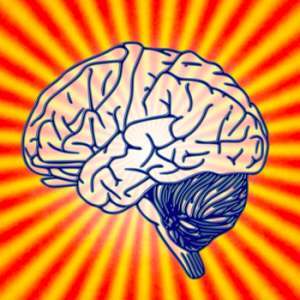 Good brain warm up exercises are hard to find, but you’ve just discovered an in-depth list of the best.
Good brain warm up exercises are hard to find, but you’ve just discovered an in-depth list of the best.
What makes a mental warm up routine good?
For one thing, it has to challenge your mind.
In order to create an effect, each warm up routine needs to produce at least a bit of friction.
By taking on the quick and creative challenges I’ve gathered for you on this page, you’ll experience exactly that:
Positive friction that produces mental dexterity, new ideas and personal growth.
Sound good?
Great! Let’s dive in!
12 Brain Warm Up Exercises That Wake Your Brain UpThis list of warm ups for your brain is a cornucopia of ideas.
They’re all good, so don’t feel that the numbers are an indicator of value.
But if you want my personal opinion?
I saved the best and most scientifically-tested exercises to wake up your brain for the end of the list.
One: List 10 Alternative Uses For An ObjectWhen I met with creativity and memory expert Tony Buzan, he challenged me to come up with ten uses for a pin lapel he was wearing.
I quickly laid out a bunch of ideas, everything from using it to make very quiet sounds on a drum, to using it like a coin in a magic trick. I even suggested that you could string enough of them together to create a ladder from here to the moon.
It’s a great exercise that creates rapid benefits, and it works with any object.
So grab an eraser, sock, book or any object you can find and jot down at least ten alternative ways it could be used.
If you can’t think of ten, don’t sweat it. But keep coming back to it throughout the day for some mini-creative exercise.
Two: Question Your DreamsI don’t know about you, but I fantasize often.
But instead of letting them drift away, I use my dreams to engage in one of the strongest morning brain exercises I know.

Here are the steps:
Write down the dream or dream fragment you rememberAsk what it reminds you of (situation, person or place)Journal briefly on any emotions or concepts that ariseYou can also do exercises throughout the day with your daydreams. This is an activity Robert Langs discusses in full in his excellent Daydream Workbook.
In brief, when you notice yourself daydreaming, make a note of the nature of the dream. And ask yourself similar questions about what memories come to mind surrounding it? What emotions, longings or fulfillments does the dray dream suggest?
There doesn’t have to be any particular outcome from this exercise. You’re just going for the brain warm up and using your dreams and day dreams to do it.
Three: Give Emotions to ColorsTake ROY G BIV, the acronym for red, orange, yellow, green, blue, indigo and violet.
Then list as quickly as you can the first emotion that comes to mind for each color. For example:
Red = angerOrange = shameYellow = happyTo take the exercise to the next level, find 3-5 alternative words for each emotion. In other words, mentally transform happiness into contentedness, comfort, mirth, cheer, elatedness, etc.
Try and do it on your own before reaching for a thesaurus.
Four: Play the Alphabet GameEither in your mind or using paper and pen, think of a name for each letter.
For example:
A = AnthonyB = BonnieC = Connie etc.Now, they don’t have to rhyme, as I’ve done, but that in itself provides interesting exercise that will stretch your mind even further.

You can also go through the alphabet and name only objects:
A = appleB = ballC = car etc.If you want to take this to the next level, have a person you name interact with an object by the same letter. Have the action also start with the same letter, like this:
Al Pacino accepts an appleBatman bounces a ballCookie monster cooks a car, etc.Sure, things might get weird, but that’s why this exercise works so well to wake up your brain.
You can take this exercise further with the pegword method or by building a PAO System.
Five: Encode Using AssociationsLet’s say you’re doing the color/emotion exercise I shared above. You’ve discovered a word in the thesaurus and you want to remember to use it more often.
Take the word and think about an image that comes to mind that can help you remember it.
For elatedness, you could seize upon the el and think about someone named Elaine arriving late.
To take another example, for mirth, you could think about frankincense and myrrh, as mentioned in the Bible.
For best results and an additional exercise, place these associations in a Memory Palace.
Six: Reading RecallGo back as far as you can in your life. For example, grade one or two.
Think of a book that you loved during that year. Or at least a book you can remember reading.
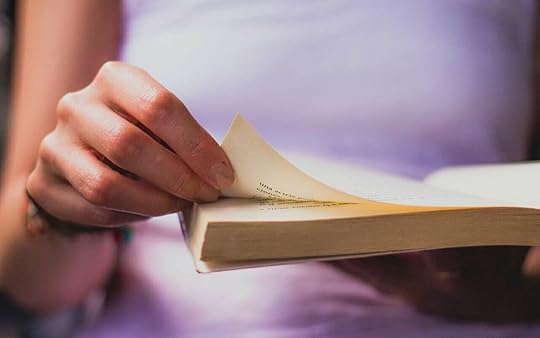
For me, I remember a book in kindergarten or grade one that involved teddy bears falling off of the book shelf they lived on. They fell onto a map spread on the floor and had to find their way back to the bookshelf from disparate lands.
The next book I distinctly remember is Where the Red Fern Grows. All I really remember about it is that there was a dog and quite a bit about hunting racoons.
Don’t worry if you have to skip entire grades or if you aren’t sure about accuracy. Just try your best to proceed on a year-by-year basis.
You can also just go year-by-year if you haven’t been in school for a very long time. The point of the warm up exercise is to stick with the yearly progression.
As an alternative, you can also use movies and try to match the year or grade you were in when you saw them.
Seven: The Movie Name GameTake a movie that you know. Then, take the last letter in the name of the movie. Use it to name another movie.
For example, if you think of Aliens, then your next movie should start with S, such as Superman. Then you would think of one that starts with N.
This exercise can get challenging fast, but push through and see how far you get. Try to name at least 10 titles before you stop.
As an alternative, you can use book titles, names of people you know or celebrities.
Eight: Combine ProductsUnlike the exercise where you name as many possible uses for an object as you can think of, here the goal is to think of mixing two objects together.
For example, imagine mixing cherry juice with mustard. Or attaching a chain saw to a car. How about an airplane that shoots spiderwebs?

See if you can get 10 combinations together.
You can also take this to the next level by getting actual objects together on a table and trying to combine them. For example, you can play around with combining:
ForkStringCoinsSalt shakerEtc.To take a simple example, you could tie the string around the coin and use it as a swinging mallet to make a dinner bell out of the salt shaker.
Nine: Combine StoriesImagine Dorothy from the Wizard of Oz.
But instead of having a dog named Toto, imagine that her pet is Scooby Doo. Then imagine how Scooby Doo would fit into the basket on Dorothy’s bike. And think about how he would react when meeting the Wicked Witch for the first time?
To continue this creative warm up exercise, have a number of movie and story titles on slips of paper. Mix them around and mishmash a few together. Then think of scenarios and what they would be like with the character swaps in place.
For more examples, imagine:
James Bond in a battle against Kermit the FrogRambo taking on the Death Star in Star WarsSherlock Holmes in The Firm instead of Tom CruiseKeeping physical books in the area where you complete your morning brain exercises is a great way to do this. Just grab a few novels or comic books and think of mix-and-match ways to create new and unusual combinations.

One of the most ice-cold mental situations people face comes from problems like PTSD and depression.
Yet, as Nic Castle, a former police officer found, using a Memory Palace helped him reduce his symptoms.
It’s not just his anecdotal experience either. Dr. Gary Dalgleish and his co-researchers have found exactly these results in their clinical trials.
You don’t have to suffer in order to benefit from using this technique as a brain warm up, however.
All you have to do is:
Have at least one Memory Palace (here’s how to create your first)Use it to memorize something (like a simple mantra)Enter your Memory Palace first thing in the morningRecite the mantraExit the Memory Palace feeling warmed upIf you really get into this practice, you can also memorize playing cards as a quick warm up. I sometimes do this before applying memory techniques to language learning.
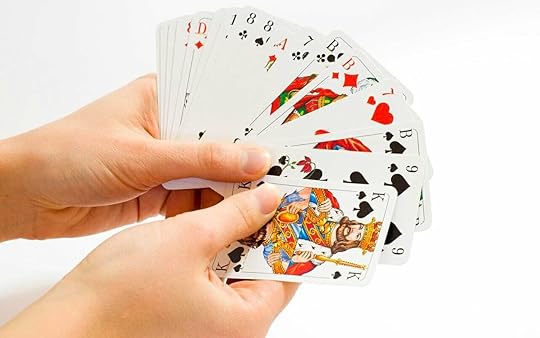
Imagine being able to solve mathematical equations within seconds?
All you have to do is learn a simple system. I recommend the Trachtenberg method.
Although learning it might not itself serve as a brain warm up, using it certainly well.
It’s a lot of fun and you can learn to use it for addition, multiplication, division and even squaring and algebraic manipulation.
Twelve: Journal About Your EmotionsResearchers found that students who journaled for 10 minutes about their emotions scored better on their exams.
Imagine that:
Getting an A instead of a B+ just by writing about how you feel.
Researchers also found that if the participants focused on their breathing while journaling, they did even better.
The catch with this study is that it was useful for students with anxiety. Having dealt with anxiety myself and used journaling, I’ve found this approach excellent in my own life for getting my brain warmed up.
I don’t see why it wouldn’t help anyone, even if they don’t have anxiety themselves.
Give it a try!
Exercises to Wake Up Your BrainAs you can see, there are many routines you can follow.
In fact, we’re just scratching the surface.
If you find that you like these brain warm up routines, there are so many more things you can do.
And if you found the Memory Palace technique intriguing, why not learn the skill in earnest?
I’ve got a whole FREE course you can register for right now:
It will take your through how to develop this simple tool so you can use it throughout the day to keep your brain sharp.
The best part?
It will help you remember the different brain warm up routines we discussed today.
So give it a try and just shout out if you have any questions along the way. I’ll get back to you a.s.a.p.




